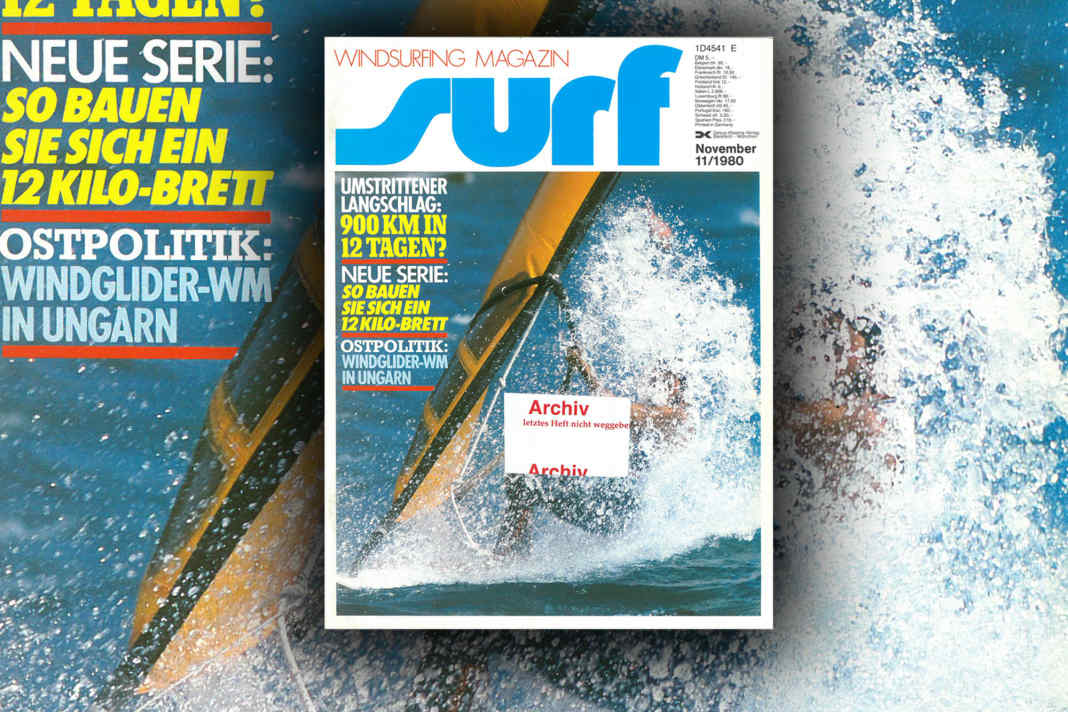





Arnaud de Rosnay - hero or baron of lies?
Today, Arnaud de Rosnay is best known for his disappearance without a trace in 1984. One of his first major expeditions on a windsurfing board was critically analysed in surf in November 1980: Did he really surf 900 kilometres across the Pacific in twelve days. One thing is certain: he set off, he arrived - but nobody knows what happened in between. Originally, "the madman with the surfboard" (Wiener Zeitung) wanted to surf 4,500 kilometres from Nuku-Hiva to Oahu, but decided at short notice to take a shorter route to the Tuamoto archipelago. Because he set off without official authorisation in a night-and-fog operation, the coast guard searched for de Rosnay for days. He not only has a special board with a water tank and inflatable frame that can be filled with air for sleeping, but also food and survival strategies developed jointly with NASA.
After arriving on the tiny island of Tua, de Rosnay claims to have eaten with the chief after a four-hour walk and then slept before informing the international press of his heroic deed. However, it was not only de Rosnay's stories from the journey ("sharks bit into my board") that caused scepticism, but also his condition: "He wouldn't have needed anything to eat, but a doctor." Other French adventurers also had doubts about the expedition and challenged de Rosnay to a competition. His response: "But only in the surf off the tip of Brittany in force eight winds."
Will Hoyle Schweitzer cancel his Olympic premiere?
Triangular, mast sleeve and boom cut-out - these three features characterise a windsurfing sail in the eyes of the judges at the Munich Higher Regional Court, and it is well known that the infamous patent was granted in 1980. Hoyle Schweitzer had his lawyers sue through the courts until he was proved right.
The situation is not much different in the USA, where Schweitzer also has a patent. He is now threatening to torpedo the Olympic premiere of windsurfing 184. If his windsurfer is not chosen as the Olympic board, the officials fear a wave of lawsuits from the patent holder, who is keen to sue. Against this backdrop, there is even talk of removing windsurfing from the programme completely. Today we know: The choice fell in favour of the Windglider - a solution that surf readers had also voted for in a survey.
Meanwhile, windglider boss Fred Ostermann spontaneously moved the World Championships for his class from the USA to Hungary. Top dog Schweitzer had grumbled against the competition regatta on his doorstep, and Ostermann sensed his chance: in a touch of windsurfing politics with the East, he moved the World Championships behind the Iron Curtain to Lake Balaton, hoping to win the votes of the Eastern officials for his windglider. With "peppers instead of palm trees and salami instead of sun", however, the local starters are at a disadvantage because they have to start with 24-kilo series boards instead of the regatta version with 18 kilos. The winner was Stephen van den Berg, who went on to win the Olympics, and seventh in the lightweight category was 13-year-old Knut Budig.
The 12-kilo speed machine
Germany in self-build fever: "The sheer joy of whizzing across the water with a hot plane much faster and more effortlessly than the others with their cumbersome industrial boards makes your chest swell when you can proudly claim on the beach: 'I built it myself'" writes author Uli Stanciu. The surf team has already built a total of five boards and is now starting a six-part series in which the shape secrets are revealed. To start with, there are the dimensions of the "surf Speed Machine", a 320-centimetre-long board that is said to be "fast, relatively stable and good-natured when tacking and jibing". There are also complete overviews of the materials and tools
You can click through the entire magazine in the gallery above!
And what else?
- The preface pays homage to the work of surf graphic designer Werner Richter: At that time, slides with pictures were still being submitted, authors had completely absurd and simply unrealisable ideas - or none at all. Werner Richter fixes it!
- How do you prevent annoying luffing? In a large overview, surf shows the advantages and disadvantages of different daggerboard and fin positions
- Mistral World Cup, Tandem World Championship, German Championship - the regatta scene is as lively as the classes are varied.
- surf offers tips for escaping the winter: Bahamas, Hawaii, Egypt, Malta, but also classics like Fuerte and Spain
- Pearls from the advert: Manufacturer Head promotes the "Hot Surf Ski" - skis with the motif of a Mistral surfer
- In the surf photo competition, the best fall pictures are to be chosen and provided with a suitable caption
More surf reviews:
- These were the highlights in surf 6/1978
- These were the highlights in surf 4/1979
- These were the highlights in surf 4/1981
- These were the highlights in surf 5/1982
- These were the highlights in surf 9/1984
- These were the highlights in surf 8/1985
- These were the highlights in surf 8/1986
- These were the highlights in surf 5/1987
- These were the highlights in surf 8/1988
- These were the highlights in surf 4/1990
- These were the highlights in surf 6/1991
- These were the highlights in surf 3/1992
- These were the highlights in surf 9/1993
- These were the highlights in surf 4/1994
- These were the highlights in surf 7/1995
- These were the highlights in surf 11-12/1996
- These were the highlights in surf 7/1997
- These were the highlights in surf 4/1999
